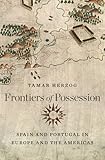Frontiers of Possession : Spain and Portugal in Europe and the Americas / Tamar Herzog.
Material type: TextPublisher: Cambridge, MA : Harvard University Press, [2015]Copyright date: ©2015Description: 1 online resource (362 p.) : 4 mapsContent type:
TextPublisher: Cambridge, MA : Harvard University Press, [2015]Copyright date: ©2015Description: 1 online resource (362 p.) : 4 mapsContent type: - 9780674735385
- 9780674735804
- 946.0009/03 23
- DP84 .H47 2015
- online - DeGruyter
- Issued also in print.
| Item type | Current library | Call number | URL | Status | Notes | Barcode | |
|---|---|---|---|---|---|---|---|
 eBook
eBook
|
Biblioteca "Angelicum" Pont. Univ. S.Tommaso d'Aquino Nuvola online | online - DeGruyter (Browse shelf(Opens below)) | Online access | Not for loan (Accesso limitato) | Accesso per gli utenti autorizzati / Access for authorized users | (dgr)9780674735804 |
Browsing Biblioteca "Angelicum" Pont. Univ. S.Tommaso d'Aquino shelves, Shelving location: Nuvola online Close shelf browser (Hides shelf browser)

|

|

|

|

|

|

|
||
| online - DeGruyter American Passage : The Communications Frontier in Early New England / | online - DeGruyter Makers of Modern Asia / | online - DeGruyter Native Tongues : Colonialism and Race from Encounter to the Reservation / | online - DeGruyter Frontiers of Possession : Spain and Portugal in Europe and the Americas / | online - DeGruyter A Chosen Exile : A History of Racial Passing in American Life / | online - DeGruyter Atatürk in the Nazi Imagination / | online - DeGruyter Thinking Small : The United States and the Lure of Community Development / |
Frontmatter -- Contents -- Introduction -- PART I. Defining Imperial Spaces: How South America Became a Contested Territory -- 1. European Traditions: Bulls, Treaties, Possession, and Vassalage -- 2. Europeans and Indians: Conversion, Submission, and Land Rights -- PART II. Defining European Spaces: The Making of Spain and Portugal in Iberia -- 3. Fighting a Hydra: 1290- 1955 -- 4. Moving Islands in a Sea of Land: 1518- 1864 -- Conclusion -- ABBREVIATIONS -- NOTES -- ACKNOWLEDGMENTS -- INDEX
restricted access online access with authorization star
http://purl.org/coar/access_right/c_16ec
Frontiers of Possession asks how territorial borders were established in Europe and the Americas during the early modern period and challenges the standard view that national boundaries are largely determined by military conflicts and treaties. Focusing on Spanish and Portuguese claims in the New and Old Worlds, Tamar Herzog reconstructs the different ways land rights were negotiated and enforced, sometimes violently, among people who remembered old possessions or envisioned new ones: farmers and nobles, clergymen and missionaries, settlers and indigenous peoples. Questioning the habitual narrative that sees the Americas as a logical extension of the Old World, Herzog portrays Spain and Portugal on both sides of the Atlantic as one unified imperial space. She begins in the Americas, where Iberian conquerors had to decide who could settle the land, who could harvest fruit and cut timber, and who had river rights for travel and trade. The presence of indigenous peoples as enemies to vanquish or allies to befriend, along with the vastness of the land, complicated the picture, as did the promise of unlimited wealth. In Europe, meanwhile, the formation and re-formation of boundaries could last centuries, as ancient entitlements clashed with evolving economic conditions and changing political views and juridical doctrines regarding how land could be acquired and maintained. Herzog demonstrates that the same fundamental questions had to be addressed in Europe and in the Americas. Territorial control was always subject to negotiation, as neighbors and outsiders, in their "idian interactions, carved out and defended new frontiers of possession.
Issued also in print.
Mode of access: Internet via World Wide Web.
In English.
Description based on online resource; title from PDF title page (publisher's Web site, viewed 30. Aug 2021)


